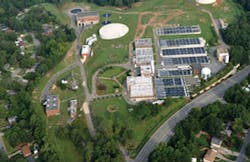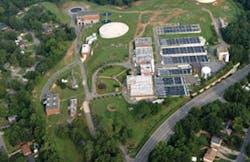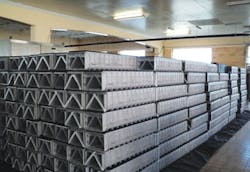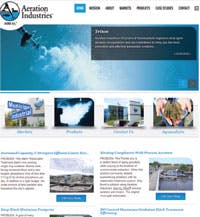Better Backwash: Major Filtration Upgrade Improves Backwash Cycles, Saves Water for Columbus Water Works
Columbus Water Works in Columbus, Ga., originated more than a century ago. The first official source of water there was Leonard Spring. From this spring, a series of pine log pipes carried water to several locations downtown where riser pipes and faucets were installed. People would come with buckets and pitchers, paying 5 cents per vessel, or the then-existing rate of $25 per thousand gallons, undelivered.
The newly minted municipal utility went on to build a treatment plant -- the North Columbus Resource Facility -- in 1915 that later received 12 additions and modifications between 1941 through 2010. Today, the utility draws raw water from the 2,150-acre Lake Oliver, a reservoir created by a hydroelectric dam built by Georgia Power across the Chattahoochee River in 1959.
Now an AWWA National Landmark, the North Columbus Resource Facility became the cornerstone of the award-
winning municipal water and wastewater utility operations. The now 90-million-gallon-per-day (MGD) plant serves 167,000 water connections, including the City of Columbus, Fort Benning Army Base and portions of two counties. The utility has a lengthy history of proactive maintenance and commitment to the highest standards of operation. It may explain why two major elements of the original construction are still in use. Most recently, the utility completed a more than $12-million retrofit in 2013 that replaced an important link in the process chain.
The contract replaced the plant's settled water filtration, which consisted of 30 dual cell filters arranged in two parallel channels within each of five masonry buildings. The non-efficient Wheeler filters were removed, including their three-part media, along with the 10-inch-poured concrete underdrains, which had the cast-in-place, waffle-like face characteristic of the Wheeler system. This was replaced with a state-of-the-art Leopold® Universal® Type SL® dual-lateral filter system fitted with a factory-installed I.M.S®(Integral Media Support) Cap, which is comprised of plastic beads sintered together and attached to the surface of the segmental underdrain.
The new filter system included an air-scour feature and stainless steel piping that optimizes the performance and durability of the system. The pre-engineered HDPE underdrain system employed a dual media (sand/anthracite) gravel-less design, maximizing system freeboard. Measurable reductions have been gained not only in the intervals but also in the duration of the backwash cycles, along with the processed water and contingent electricity usage, noted James Stephens, the municipal utility's superintendent of water treatment.
"We originally set out to do only a filter media replacement project because 40 percent of the media was 36 years old, and the other 60 percent was 26 years old," he said. "The utility decided to undertake a much more proactive program. We evaluated several types of replacements, including membrane technology, restoring conventional gravity filtration like that in place, and the option of replacing the entire Wheeler ball underdrain and media with the Leopold dual lateral system and advanced controls. A visit to the Leopold research facility convinced me to recommend their system along with other upgrades."
He continued, "Although we are bringing up the backwash run times slowly, we already run our backwashes at just under 200-hour intervals and have achieved notable improvements."
The utility's source water drawn from Lake Oliver normally ranges from 2 to 3 nephelometric turbidity units (NTUs) but can reach turbidity levels many times higher after torrential rains soak the watershed upstream along the Chattahoochee River. Although the former filters still delivered the desired quality, the hours of operation had eroded from 225-hour intervals between backwashes in the early 1990s to just 125-hour intervals in the years immediately prior to the replacement project. In lockstep with reduced run times, the shorter intervals between backwashes also experienced a 2.5-foot loss of head immediately after backwashes, which presented an issue when the desired maximum head range was 6 feet for normal operating conditions on the filter unit during the peak summer months.
Prior to the filter rehabilitation, the backwash procedure consisted of a hydraulic-only backwash, where the high-rate wash cycle would last up to 20 minutes. Backwashing each dual cell filter used approximately 150,000 to 200,000 gallons of water. The filters would then operate up to an hour in a rewash or filter-to-waste operation to reach the desired output of <0.09 NTUs. The rehabilitation filters with integral air scour reduced the filter high-rate backwash down to only five minutes, and filter rewash time was also drastically reduced, lasting on average about 15 to 20 minutes. The new backwash cycle only utilizes approximately 90,000 gallons for each dual cell filter.
"Before the rehabilitation, we were using 5 percent of our production water for filter backwash purposes. We are now using 1.8 percent of our production water," said Stevens. On average, the facility is producing 32 MGD. With the Leopold filter system, the plant is saving approximately 1,000,000 gallons of water per day that was previously used for backwash purposes.
Upgrade Addresses Broad Scope of Work
The Norcross office of the Jacobs Group (formerly Jordan Jones & Goulding) served as the utility's consultants for the project, which was awarded to RTD Construction Inc., a contractor headquartered in Zephyrhills, Fla., with broad experience in waterworks projects. Leopold provided on-site technicians to ensure proper installation.
The RTD contract covered extensive structural concrete replacement associated with demolition of the cast-in-place, 12'-x-21'-x-10" Wheeler underdrain slab; removal and replacement of the degraded sand/anthracite/gravel media; removal and replacement of 420 existing hydraulic-actuated filter valves with electric motor-actuated valves; and addition of four new blowers and stainless steel piping for the air-scour system. Replacements also involved a 150-HP backwash pump; two 1,000-HP raw water pump motors; two 350-HP related service motors, starters and controls for the pumps; 36-inch and 24-inch yard valves; actuators; and a new precast valve vault. The demolition replacement activity required temporary removal of windows to create access for the contractor's material-handling needs.
The work required over a year in stages at each filter building to install the new Leopold filter system. The new dual-lateral system consists of 30 dual cell filters (60 cells total) with each cell measuring 12'3" x 21'3". The systems filtration area totals 15,660 square feet. The two-part media consisted of 17,128 cubic feet of silica sand (856 tons) sized from 0.45 mm to 0.55 mm, and 31,320 cubic feet (783 tons) of filter-grade anthracite sized from 0.95 mm to 1.05 mm in a 22-inch depth.
The pre-engineered underdrain blocks are mechanically fixed and align end-to-end before being sealed with O-rings to create continuous parallel laterals in the approximate lengths of the filter cells. The gravel-less media also yielded an increase in water depth atop the filters, ranging from 6 to 8 inches, adding to the overall system freeboard. The now two-part media achieves greater efficiency and volume and a more thorough backwash from the air-scour technology first introduced by Leopold in 1977.
"In addition to longer intervals between backwashes, the new filters have brought the loss of head from 2.5 to just a half-foot loss," Stephens said. "As I look back on this project, replacing only the media in the Wheeler ball system would have restored the desired quality but not the net gain in quantity of production. The project eliminated the limitations on our run times in summer." He added that the NTU range achieved from the filters is only slightly above that of the membrane filters at a new plant the utility built and now operates on Fort Benning.
Stephens has seen many improvements in process technologies since he started his 21-year career at Columbus Water Works. He clearly considers the advancement in filtration among the most impressive.




